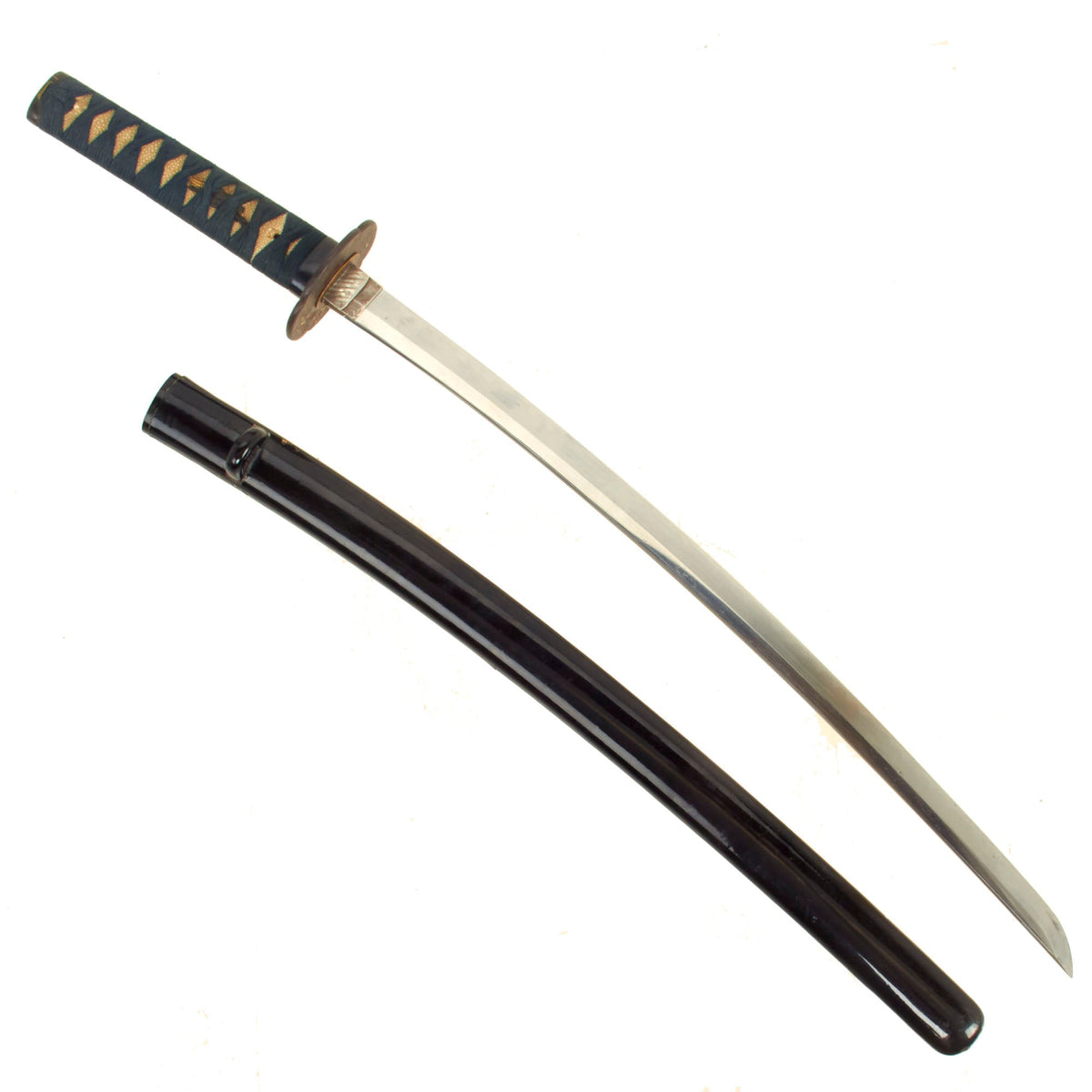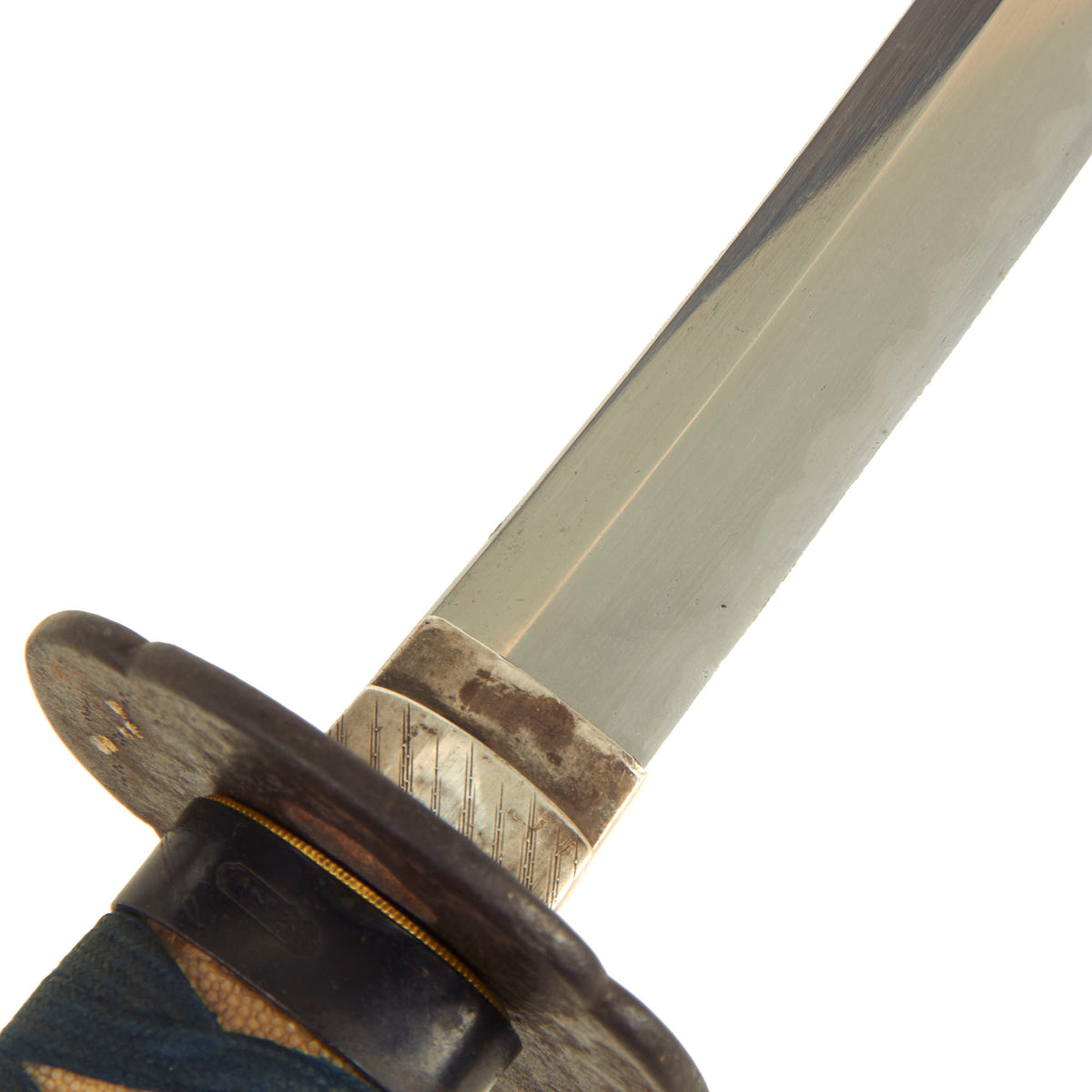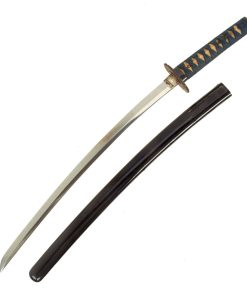Original 18th Century Edo Period Japanese Handmade Wakizashi Short Sword by MUNEHISA with Lacquered Scabbard Original Items
$ 2.795,00 $ 698,75
Original Item: Only One Available. Wakizashi (脇差 “side inserted / companion sword”) is a general term for a sword with an edge between one and two shaku long (30 cm and 60 cm), predominantly made after 1600. Generally it is the short blade that accompanies a katana in the traditional samurai daisho pairing of swords, but may be worn by classes other than the samurai as a single blade, also worn edge up as the katana.
This example dates from the Edo period (江戸時代, Edo jidai) or Tokugawa period (徳川時代, Tokugawa jidai) of Japanese history. This is the period between 1603 and 1867, when Japan was under the rule of the Tokugawa shogunate and the country’s 300 regional daimyo. As the blade length is close to that of a Katana, and the blade is the “Shinogi-Zukuri” shape, some would term this an “O-Wakizashi”.
This example has most likely been remounted several times, as was common for Japanese blades that are several hundred years old. Age and wear have made the file marks (yasurimi) on the tang faint, and given it a lovely patina. This has however also made the mei, or signature on the blade harder to read, and removed the tagane-makura (raised area around the mei). The tagane (chisel marks) are however still visible, and as best we can tell, the blade is signed 常 陸 守 宗 久- HITACHI NO KAMI MUNEHISA. This is not a very common name, and from cursory research we have not bee able to locate much on this smith. Definitely some great potential for further research!
The blade has the following period correct features:
– Folded steel blade (fold lines are evident on the spine and body of the blade)
– hole (mekugi-ana) in the tang is punched and not drilled
– blade is signed on the tang by the maker.
– Vibrant visible temper line (“hamon”) running full length of blade cutting edge, including on the tip (boshi).
– Hada or Grain is visible throughout the blade surface.
– Ware Kizu (blade wounds) from lamination artifacts, only possible on handmade blades.
Offered in very good condition, the blade of this example measures 20 1/4 inches long and is in great condition. It looks to have seen very little wear since the last time it was traditionally polished, and not had uchiko powder used on it. The temper line and other aspects of the blade are easily visible, iridescent in the light. Unfortunately it is nearly impossible to catch the true beauty of this blade with photographs. There is just a bit of oxidation in areas, and a few light scuffs. The edge is still quite sharp, so care is needed, and there are no nicks or other damage we can see. The blade tang (nakago) is of the futsu 普通 (regular) style, with a Iriyamagata (asymetrically pointed) nakago-jiri (tang tip). Overall length of this wakizashi is 28 1/4 inches.
The HAMON (刃文) temper line is easily visible, and is a very attractive and active GUNOME MIDARE (互の目乱れ – irregularly undulating) zig zag style. Along the transition there are clear NIE crystals visible, with cloudy areas of NIOI in the body of the hamon. There is also a lot of internal activity and visible crystallization, something not usually seen on more modern blades. The tip temper line (BOSHI) is still fully visible, and is the JIZOU (地蔵 – Buddha’s Head) shape, which is highly desirable. The YOKOTE (横手 – transition to the tip) is fully visible, and the blade has a proper geometric KISSAKI (tip).
The body of the blade has clear hada (grain), which is of the ITAME (板目 – Wood Grain) pattern. We can see some blade wounds (傷 – KIZU) such as WARE (割れ- lamination lines) and very small FUKURE (脹れ – Carbon pits). These are only possible on true traditionally made blades. This is really a fantastic looking blade! With the long delay for traditional togishi polishing, blades like this that are ready to display are definitely in demand. The sword has a two piece silver Habaki (blade collar), which is typical of the early Edo period.
The tsuba (cross guard) is made of well-patinated iron and is of the iconic MOKKO GATA (quince) shape, showing some lovely embossed designs and a bit of brass inlay work. There are two hitsu-ana cut outs on either side of the blade, used for the handles of accessories such as Kogatana knives and kogai hair pins. There are 2 gilt copper SEPPA (spacers) around the tsuba to keep the fight tight, though it is now a bit loose.
The fuchi (collar) for the tsuka (handle) is blacked copper/brass, as is the KASHIRA (End Cap), and both show some lovely designs. The stingray (Sa-Me) grip is in very good condition, with a lovely dark aquamarine colored ITO grip wrapping, which holds the end cap in place. It is in really good condition, showing some light staining. There are two matching blacked copper menuki present, which look to be birds with nesting material, showing gilt highlights. The handle is held in place by a single securing peg. Really a nice handle!
The sword comes in a a well fitting gloss black lacquer wooden scabbard (SAYA), which has an accessory slot on one side for a kogatana knife, which is unfortunately not included. The scabbard is in very good condition, with very little missing finish, and just a bit of splitting along the seams. It has a KURIKATA (knob) for a sword cord, though it looks to have been reglued at some point.
A very nice Edo Period O-wakizashi in great polish, complete with some very nice fittings. Ready to display!
Specifications:
Blade Length: 20 1/4″
Blade Shape: Shinogi-Zukuri (鎬造
Overall length: 28 1/4“
Scabbard Length: 21 1/2″
It has been over one thousand years ago that the art of making swords appeared in Japan. The swordsmiths of the time may not have known it but they were creating a legendary sword. The Samurai sword has seen combat in many battlefields. From the early days of the Samurai warrior to the fierce battles in the South Pacific during WWII.
Each hand-made Japanese blade (日本刀 – Nihonto) is unique because it is forged from multiple pieces of folded steel stock. A tremendous amount of work is dedicated to creating these pieces. They were an instrument of war as much as a beautiful artifact to adorn a room.
The traditional Japanese blade and mountings have grown to be one of the most highly desired military antiques.
Fast Shipping with Professional Packaging
Thanks to our longstanding association with UPS FedEx DHL, and other major international carriers, we are able to provide a range of shipping options. Our warehouse staff is expertly trained and will wrap your products according to our exact and precise specifications. Prior to shipping, your goods will be thoroughly examined and securely secured. We ship to thousands clients each day across multiple countries. This shows how we're dedicated to be the largest retailer on the internet. Warehouses and distribution centres can be located throughout Europe as well as the USA.
Note: Orders with more than one item will be assigned a processing date depending on the item.
Before shipping before shipping, we'll conduct a thorough inspection of the items you have ordered. Today, the majority of orders will be delivered within 48 hours. The delivery time will be between 3-7 days.
Returns
The stock is dynamic and we cannot completely manage it because multiple stakeholders are involved, including our factory and warehouse. So the actual stock may alter at any time. It's possible that you may not receive your order once the order has been made.
Our policy is valid for a period of 30 days. If you don't receive the product within 30 days, we are not able to issue a refund or an exchange.
You can only return an item if it is unused and in the same state as the day you received it. You must have the item in its original packaging.
Related products
Uncategorized
Uncategorized
Uncategorized
Uncategorized
Uncategorized
Band of Brothers ORIGINAL GERMAN WWII Le. F.H. 18 10.5cm ARTILLERY PIECE Original Items
Uncategorized
Uncategorized
Angolan Rebel 1970s era 60mm Inert Display Mortar from Angolan Civil War Original Items
Uncategorized
Uncategorized
Uncategorized
Uncategorized
Uncategorized
Uncategorized
Uncategorized
Uncategorized
Uncategorized
Uncategorized













































































